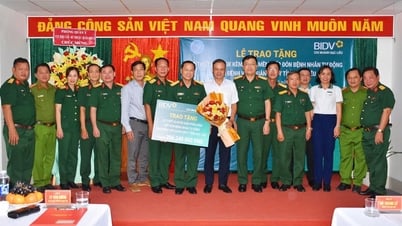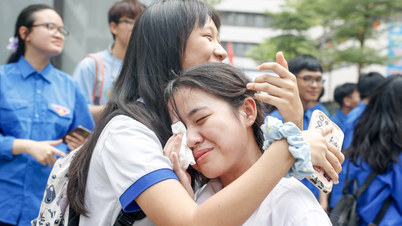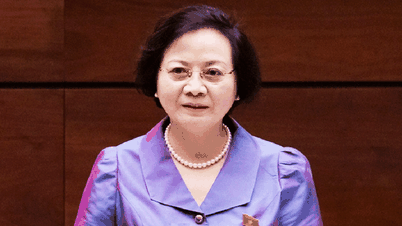
Scene of the morning meeting on November 27 - Photo: GIA HAN
On the morning of November 27, with 431/468 National Assembly deputies participating in the vote in favor (accounting for 87.25% of the total number of National Assembly deputies), the National Assembly officially passed the Law on Identification. The law consists of 7 chapters and 46 articles.
Many changes on the ID card
Accordingly, the newly passed Law on Identity Cards has clearly stated the changed information fields shown on the identity card.
Including facial photo; personal identification number; last name, middle name and given name; date of birth; gender; place of birth registration; nationality; place of residence; card issue date and expiry date.
Thus, compared to the 2014 Citizen Identification Law, the fields for information about hometown and fingerprints have been removed and do not need to be shown on the ID card.
Information in the Identity Database includes identity information; biometric information including facial images, fingerprints, irises, DNA, voice; occupation...
In particular, DNA and voice information are only collected when people voluntarily provide it or during the process of managing people subject to administrative measures.
People who are granted ID cards include Vietnamese citizens from 14 years of age and above who must carry out ID card issuance procedures; Vietnamese citizens under 14 years of age are granted ID cards upon request.

Voting results to pass the Law on Identification - Photo: THANH CHUNG
Changing the identity card name is suitable for the purpose of management and serving the people.
Before the National Assembly voted to pass, on behalf of the National Assembly Standing Committee, presenting the inspection report, Chairman of the National Defense and Security Committee Le Tan Toi said that there were opinions that in the past there had been many changes in the form, content and name of the ID card, so it was suggested to consider the name of the law.
At the same time, it is recommended not to change the name of the law and the name of the card to ID card.
However, Mr. Toi said that through discussion, most of the delegates' opinions and the opinions of the National Assembly Standing Committee agreed with the name of the draft law and the name of the identity card that had been explained.
The National Assembly Standing Committee believes that the use of the name Law on Identification clearly demonstrates its scientific nature, both covering the scope of regulation and subjects of application of the law, and being consistent with the trend of digital society management.
By integrating full information scientifically in the ID card along with the form and method of digital management to ensure popularity, the name change to ID card will help make state management more scientific, serving the digital transformation, digital economy , and digital society of the Government.
At the same time, create favorable conditions and support for people to participate in social activities as well as administrative and civil transactions more and more conveniently.
Mr. Toi also said that the National Assembly Party Delegation had asked for the Politburo's opinion on this content and the Politburo agreed and highly agreed on the use of the name of the Law on Identification and Identification Card as proposed by the Government.
The Standing Committee of the National Assembly finds that the adjustment of the name to the Law on Identification and Identification Cards is appropriate for the purpose of management and serving the people.
Besides, according to Chairman of the National Defense and Security Committee Le Tan Toi, current science has proven that along with fingerprints, a person's iris has a complex and unique pattern structure for each person, which does not change much over time.
Iris recognition technology (also known as iris sensor technology) is a method of using algorithms and images to identify a person based on the structure of the iris lines (where the human eye color is determined), which has been widely applied in many fields.
Currently, many countries have applied this technology to serve citizen identification, passport authentication, filling in authentication information via website...
At the same time, this technology is highly accurate, simple, easy to use, and does not require complicated operations.
Therefore, in addition to collecting fingerprints, the draft law has added regulations on collecting irises in identification information to serve as a basis for checking and authenticating each individual's information.
Support in cases where a person's fingerprints cannot be collected (in cases of disabilities or deformed fingerprints due to objective or subjective reasons...)./.
According to TTO
Source: https://tuoitre.vn/quoc-hoi-chinh-thuc-thong-qua-doi-ten-can-cuoc-thu-thap-them-mong-mat-vao-co-so-du-lieu-can-cuoc-20231127082940977.htm
Source

























![[Photo] Nearly 104,000 candidates in Hanoi complete procedures to take the 10th grade entrance exam](https://vphoto.vietnam.vn/thumb/1200x675/vietnam/resource/IMAGE/2025/6/7/7dbf58fd77224eb583ea5c819ebf5a4e)



























































![[OCOP REVIEW] Tu Duyen Syrup - The essence of herbs from the mountains and forests of Nhu Thanh](https://vphoto.vietnam.vn/thumb/402x226/vietnam/resource/IMAGE/2025/6/5/58ca32fce4ec44039e444fbfae7e75ec)







Comment (0)